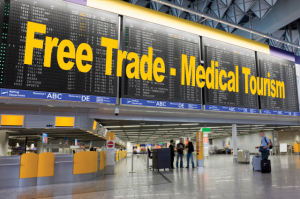Free Trade - Medical Tourism
by
Joan Trombetti, Writer | January 28, 2009

Medical travel
is growing
The U.S. medical tourism industry, though burgeoning, is still in its early stages. Its development will be dictated by a variety of market factors and the reactions of a variety of market sectors including patients, insurers and employers. In addition, whether the industry can effectively demonstrate the quality of medical care abroad and provide a reasonable degree of comfort for patients and employers with respect to possible bad outcomes will affect its development. -Dale Van Demark, Member, Epstein, Becker Green P.C., Washington, DC.
The Deloitte Center for Health Solution's report on Medical Tourism estimates that in 2007, 750,000 Americans traveled abroad for medical care, and that number is expected to increase to six million by 2010. This means that the base-case for the annual growth rate in outbound medical tourism is estimated at 100% from 2007 to 2010. The report identifies three medical tourism categories - outbound, inbound and intrabound (domestic).
Medical travel to countries outside the United States and to it has existed for many years. In developing countries, the influx of incoming medical tourists was initially limited because of constraints like poor communications, transportation, water and sewer systems and electricity and power generation. As economic development took root, the resources and opportunities became available to build health care centers for people to travel to from all parts of the world. Today, there are high-quality, customer-service oriented hospitals and facilities in developing nations like India and Thailand that provide medical care at costs sometimes as much as 80% lower than in the U.S. Often times, this savings includes airfare and a stay in a resort hotel. Thus, many under-insured or uninsured residents of the U.S. choose medical treatment abroad because of the high cost of health care at home.
The American Medical Association (AMA) has acknowledged the growth in medical tourism by adopting new guiding principles - a first of its kind - outlining steps for care abroad for consideration by patients, employers, insurers and third parties responsible for coordinating travel outside the U.S. The AMA guidelines come at time when U.S. health insurance companies and employers are considering making "medical tourism" a part of health benefit packages offered. As an example, CIGNA, Aetna and Blue Cross/Blue Shield have begun or are considering pilot programs that provide limited coverage for foreign care.
